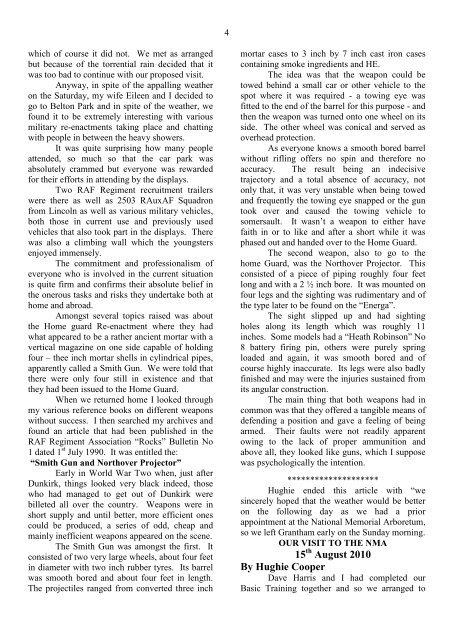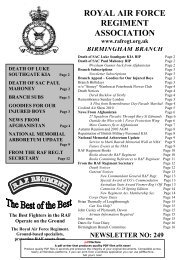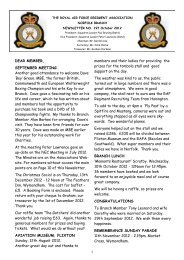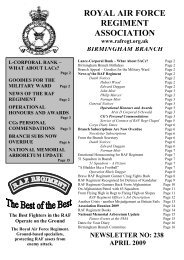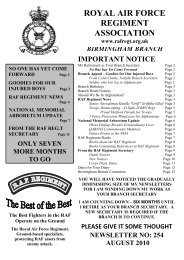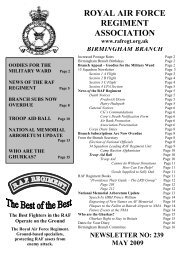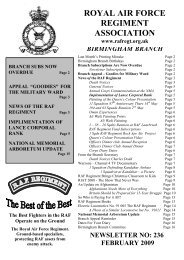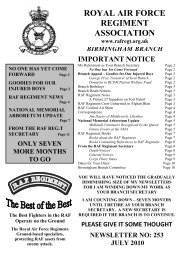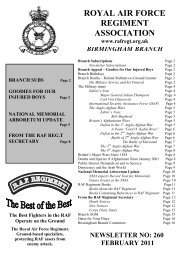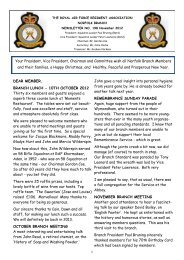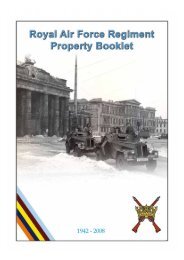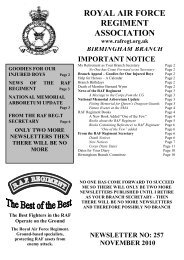September 2010 - RAF Regiment Association Official Website
September 2010 - RAF Regiment Association Official Website
September 2010 - RAF Regiment Association Official Website
You also want an ePaper? Increase the reach of your titles
YUMPU automatically turns print PDFs into web optimized ePapers that Google loves.
4<br />
which of course it did not. We met as arranged<br />
but because of the torrential rain decided that it<br />
was too bad to continue with our proposed visit.<br />
Anyway, in spite of the appalling weather<br />
on the Saturday, my wife Eileen and I decided to<br />
go to Belton Park and in spite of the weather, we<br />
found it to be extremely interesting with various<br />
military re-enactments taking place and chatting<br />
with people in between the heavy showers.<br />
It was quite surprising how many people<br />
attended, so much so that the car park was<br />
absolutely crammed but everyone was rewarded<br />
for their efforts in attending by the displays.<br />
Two <strong>RAF</strong> <strong>Regiment</strong> recruitment trailers<br />
were there as well as 2503 RAuxAF Squadron<br />
from Lincoln as well as various military vehicles,<br />
both those in current use and previously used<br />
vehicles that also took part in the displays. There<br />
was also a climbing wall which the youngsters<br />
enjoyed immensely.<br />
The commitment and professionalism of<br />
everyone who is involved in the current situation<br />
is quite firm and confirms their absolute belief in<br />
the onerous tasks and risks they undertake both at<br />
home and abroad.<br />
Amongst several topics raised was about<br />
the Home guard Re-enactment where they had<br />
what appeared to be a rather ancient mortar with a<br />
vertical magazine on one side capable of holding<br />
four – thee inch mortar shells in cylindrical pipes,<br />
apparently called a Smith Gun. We were told that<br />
there were only four still in existence and that<br />
they had been issued to the Home Guard.<br />
When we returned home I looked through<br />
my various reference books on different weapons<br />
without success. I then searched my archives and<br />
found an article that had been published in the<br />
<strong>RAF</strong> <strong>Regiment</strong> <strong>Association</strong> “Rocks” Bulletin No<br />
1 dated 1 st July 1990. It was entitled the:<br />
“Smith Gun and Northover Projector”<br />
Early in World War Two when, just after<br />
Dunkirk, things looked very black indeed, those<br />
who had managed to get out of Dunkirk were<br />
billeted all over the country. Weapons were in<br />
short supply and until better, more efficient ones<br />
could be produced, a series of odd, cheap and<br />
mainly inefficient weapons appeared on the scene.<br />
The Smith Gun was amongst the first. It<br />
consisted of two very large wheels, about four feet<br />
in diameter with two inch rubber tyres. Its barrel<br />
was smooth bored and about four feet in length.<br />
The projectiles ranged from converted three inch<br />
mortar cases to 3 inch by 7 inch cast iron cases<br />
containing smoke ingredients and HE.<br />
The idea was that the weapon could be<br />
towed behind a small car or other vehicle to the<br />
spot where it was required - a towing eye was<br />
fitted to the end of the barrel for this purpose - and<br />
then the weapon was turned onto one wheel on its<br />
side. The other wheel was conical and served as<br />
overhead protection.<br />
As everyone knows a smooth bored barrel<br />
without rifling offers no spin and therefore no<br />
accuracy. The result being an indecisive<br />
trajectory and a total absence of accuracy, not<br />
only that, it was very unstable when being towed<br />
and frequently the towing eye snapped or the gun<br />
took over and caused the towing vehicle to<br />
somersault. It wasn’t a weapon to either have<br />
faith in or to like and after a short while it was<br />
phased out and handed over to the Home Guard.<br />
The second weapon, also to go to the<br />
home Guard, was the Northover Projector. This<br />
consisted of a piece of piping roughly four feet<br />
long and with a 2 ½ inch bore. It was mounted on<br />
four legs and the sighting was rudimentary and of<br />
the type later to be found on the “Energa”.<br />
The sight slipped up and had sighting<br />
holes along its length which was roughly 11<br />
inches. Some models had a “Heath Robinson” No<br />
8 battery firing pin, others were purely spring<br />
loaded and again, it was smooth bored and of<br />
course highly inaccurate. Its legs were also badly<br />
finished and may were the injuries sustained from<br />
its angular construction.<br />
The main thing that both weapons had in<br />
common was that they offered a tangible means of<br />
defending a position and gave a feeling of being<br />
armed. Their faults were not readily apparent<br />
owing to the lack of proper ammunition and<br />
above all, they looked like guns, which I suppose<br />
was psychologically the intention.<br />
********************<br />
Hughie ended this article with “we<br />
sincerely hoped that the weather would be better<br />
on the following day as we had a prior<br />
appointment at the National Memorial Arboretum,<br />
so we left Grantham early on the Sunday morning.<br />
OUR VISIT TO THE NMA<br />
15 th August <strong>2010</strong><br />
By Hughie Cooper<br />
Dave Harris and I had completed our<br />
Basic Training together and so we arranged to


